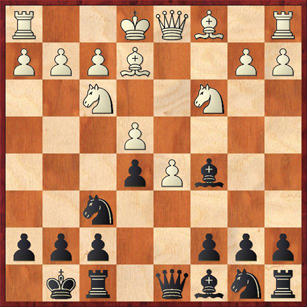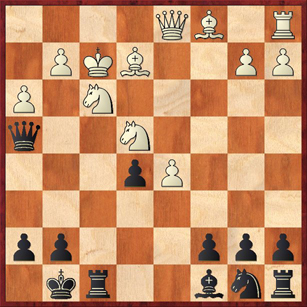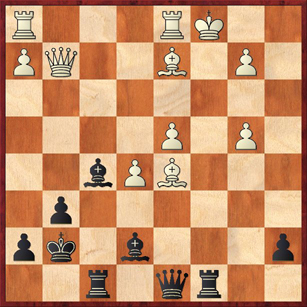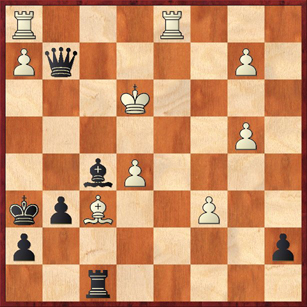Yesterday I met a “new kid in town,” whose name is Pablo Pena. There are a couple of Pablo Penas in the U.S. Chess Federation database, but I suspect he is probably the one from Oregon who has a USCF rating of 2082.
The occasion was the second Sunday quad/blitz tournament organized by Jim Parker. Pablo made a pretty good splash in his debut! He blew everyone away, going 3-0 in the 30-minute quads and then 12-0 in the 7-minute blitz tournament. I’m worried now that he will think that Santa Cruz doesn’t have good enough opposition for him, and he will stop playing here …
My game with Pena (click on highlighted text for PGN) in the quad was kind of interesting, and I definitely had some chances. Pablo had White, and the game began with one of my usual offbeat openings: 1. d4 Nf6 2. c4 d5 3. cd Nxd5 4. e4 Nf6 5. Nc3 e5 6. d5 Bc5 7. Be2 O-O 8. Nf3.
Of course the natural move for Black is 8. … Re8, but I vaguely remembered having gone over this position on the computer and remembered that the computer had suggested “something tricky.” But I didn’t remember what it was! So I screwed up my courage and played the extremely dubious 8. … Ng4?!
This is a good example of how computer “analysis” can lead you to play moves that you would never have played if left to your own devices. The move the computer suggested was 8. … c6!?, which Fritz does consider to be better than 8. … Re8 (though not dramatically so). I looked at 8. … c6 over the board but I wasn’t convinced that I could win back the gambit pawn. Now that I’ve gone over the position more carefully I think I understand where Black’s compensation is … but that is a subject for another time.
The move I played, 8. … Ng4, is wrong, of course, but that doesn’t mean it’s easy to refute. The game continued 9. O-O f5?! 10. h3 Nxf2 11. Rxf2 Bxf2+ 12. Kxf2 fe 13. Nxe4 Qh4+ and now White is at a crossroads.
What is White’s best way out of the check: 14. Ke3 or 14. Ng3?
First let me make a general comment that is mostly directed at novices, if there are any reading this blog. One of the most confusing exchanges to evaluate is the exchange of R+P for two pieces, usually B+N. If you have memorized the “points table,” according to which rooks are 5 points, and bishops and knights are 3 points, it looks like an even trade. But it’s not. In fact, it’s not even close. The two pieces are usually much better. Why? Well, one reason is that a bishop is really worth a little more than 3 “points,” it’s more like 3.2 or 3.3. And a rook probably isn’t quite worth 5, it’s more like 4.8 or 4.9. Such statements would have seemed nonsensical 30 years ago, but nowadays, in the computer era, they kind of make sense.
But putting aside the question of point counts, the thing is that when you have a bishop and knight you have two attacking pieces. A rook and a pawn are usually only one attacking piece. So the rook and pawn are only sufficient compensation if (1) the bishop or the knight are extremely crippled; or (2) the pawn is extremely active, especially if it’s an endgame. In the middlegame, where this question usually comes up, situation (2) rarely occurs. For that reason, you will almost never see masters voluntarily give up two pieces for a rook and pawn. They will only consider the trade if they get at least a rook and two pawns. (And by the way, if the two pieces are two bishops, even a rook and two pawns are often not enough. See below!)
So it’s important to realize that, in the position above, material is NOT even; I headed for this position knowing it was a sacrifice.
I assumed here that 14. Ng3 was bad because it leaves the king and knights in an awkward situation where none of them can move. In particular, when I was calculating this (back at move 8 — six moves ago!) I thought that 14. … e4 was just winning. I missed White’s response 15. Qd4, which pins and wins the e-pawn! If Black doesn’t play 14. … e4, say if he plays 14. … Nbd7 (which the computer says is best), it’s too slow. The computer says that 15. d6! is completely winning. Either the queen goes to d5 and then e4, or it goes to b3 and then c4. This breaks Black’s bind, which is dependent on his queen being at h4. Black just can’t get his remaining pieces into the attack sufficiently quickly.
Nevertheless, Pablo had the same hallucination that I did! He played 14. Ke3? and the game continued 14. … Qf4+ 15. Kd3 Qf7 16. Qb3. The computer says that this is a mistake and White should play 16. Kc3, but that is a move no normal human would play. The game continued 16. … Bf5 17. Ng5 and now we come to our last position of interest.
How should Black continue his attack?
Here I made a very instructive mistake. Because I wanted to build up pressure on White’s d-pawn with … Rd8, I played 17. … Bxe4+? 18. Nxe4, after which White is probably just winning. This move was wrong for two reasons — and it doesn’t require any tactical analysis to see why. First, by making this exchange Black gives White two bishops against a rook and pawn. This means that White can actually afford to give up a pawn and still be better in material. And that is exactly what happened. He eventually pushed his pawn to d6, sacrificing it, but in the process creating a position where the bishops dominated the board. Second, as a general principle, when you are attacking you want to keep all the tension on the board and avoid trading pieces. Therefore, Black’s best move had to be 17. … Qg6, building up the pressure on e4 and avoiding a premature clarification of the position. The computer rates the position as about even, but given the fast time control and the flawed human beings playing the game, I think Black has better practical chances.
I’ll stop here, but you should play over the rest of the game using the PGN if you want to see how White sets up a favorable B+B versus R+2P situation.
Pablo also had an exciting game against Dan Burkhard in the third round of the quad. In fact, he got unbelievably lucky. Dan played a beautiful attack and then just fell asleep. (PGN here.)
Black has just played … Ra8-c8+, leaving White with only two options. Pablo surprised me by playing 1. Bc6. Perhaps he saw that after 1. Bc3 Black just destroys him with 1. … Bxb4 2. Kd2 Qa5 3. Rc1 Rfd8! The bishop on d5 can’t be defended, but if it moves away, Black is going to crash through with … Rd4+.
After 1. Bc6 Dan comes up with a very nice winning idea. He plays 1. … Bg5! According to the computer, the brutal 1. … Qb6 is even more effective, but Dan’s idea is certainly more attractive. The point is that 2. Bxg5 would be met by 2. … Rxc6+! 3. Qxc6 Qxg5+ 4. Rd2 Rc8, skewering the queen and king. Instead, Pablo played 2. d5, but the exchange sac is still devastating: 2. … Rxc6+! 3. dc Qd3.
At this point, if I were White, I would have seriously considered resigning — particularly since Dan still had plenty of time on the clock (6 minutes). But Pablo kept on playing: 4. Bxg5 Qb1+ 5. Kd2 Qc2+ (actually, there is no reason to avoid taking on b2, but Dan was just in love with his queen-bishop battery) 6. Ke3 Qxg2 7. Bh6+ and now a very curious move: 7. … Kh6.
Strictly speaking, there is nothing wrong with this move, nothing at all. But there are all sorts of interesting things going on psychologically under the surface. First, Dan says that the reason he didn’t play a more natural move like 7. … Rxf6 or even 7. … Kf7 is that he forgot that his bishop was controlling the square d7 and thus keeping White’s rook out. It’s funny that he forgot about this piece, which was really the star of the show in the earlier variations. Second, the move … Kh6 is the sort of move that you should never, never play in a position where you are winning, because it sets up a crazy, unlikely possibility that Black could get checkmated. It is a harbinger. Potential checkmates have a horrible way of turning into actual checkmates, even when they shouldn’t.
Dan forgot to apply Andres Hortillosa’s main rule for avoiding blunders: Always be conscious of the worst possible thing that could happen to you, and don’t let it happen.
Now Pablo played 8. Rhg1, also a clever move psychologically. I would have been tempted to play 8. Rd4, threatening checkmate right away, but the problem with this move is that it’s too obvious. Black would realize that White has something up his sleeve; he wouldn’t just leave his rook on h1 undefended for no reason. Dan played 8. … Qxc6, and now Pablo played 9. Rd4 — a normal-looking move, giving away nothing of his intentions. And Dan, who still had four minutes left on his clock, played 9. … Qe6???, allowing 10. Rh4 checkmate! The helpmate is complete.
So … Great performance by Pablo, but …
As for my performance, it was okay but not great. In the quad I went 1-2, losing to Pablo and Dan but beating Ilan Benjamin. (Also a blunder-filled game, but I won’t embarrass him and me by showing it to you.) In the blitz tournament I scored 9.5 out of 12 to finish second. Pablo had 12 for first, Al Abraham finished third with 8.5 and Thadeus Frei tied with David Duquette for fourth with 8 points. Although second place was okay, I was disappointed that I lost two games in a row to Pablo and Al near the end. In both games I was a pawn up at some point, and in the game against Al I completely botched a won endgame. Oh well. It’s 7-minute chess, what do you expect?








{ 8 comments… read them below or add one }
Where are Santa Cruz chess tournaments listed? Not at Calchess.org.
I know this is tangential to your point, but I just wanted to comment on one thing you said, since I recently came across an old listing of relative piece values.
“Well, one reason is that a bishop is really worth a little more than 3 “points,†it’s more like 3.2 or 3.3. And a rook probably isn’t quite worth 5, it’s more like 4.8 or 4.9. Such statements would have seemed nonsensical 30 years ago, but nowadays, in the computer era, they kind of make sense.”
In “The American Chess Player’s Hand Book” (revised edition, 1934), the following values for the pieces are given:
Pawn: 1.00
Knight: 3.07
Bishop: 3.50
Rook: 5.48
Queen: 9.94
Interesting that 80 years ago they used two decimal places. 🙂
Ashish, these tournaments that Jim Parker runs are unrated. There was a rated tournament in May that I wrote about, at Cabrillo College. I don’t know whether that one got listed at Calchess or not.
Scott, Very interesting! What has changed is that computers can actually test these values and see what works best in practice. I would be very interested to hear what values Rybka or Fritz assign to pieces.
A few years ago Hans Berliner came out with a rather controversial book called “The System,” and he gave a table of piece values to one decimal place. Because he was one of the first strong players to program a chess computer (HiTech) I assume his values were informed to some extent by his experience with the computer. Unfortunately I do not remember all of his values, but I remember that he put the queen’s value at 8.8 and he said that there is an extra 0.5-pawn bonus for the two bishops. That was one consideration that encouraged me in studying the Bryntse Gambit/ Queen Sac Variation in the Sicilian. If White can get 2B’s and 2P’s versus Blacks’ Q, he is already close to material equality (8.5 points to 8.8). At least if you believe Berliner’s “system,” which is of course very debatable.
When you play the Marshall Defence how many people play 4.e4 and how many play 4.Nf3? I’m a little bit surprised an Expert didn’t know about the latter move.
10 h3 looks like a waste of a tempo and creates weak black squares around the King side at the same time.
I would prefer 10 Bg5 and 11 Rc1 completing development and asking Black to show what attack he can generate with his entire Q-side still at home.
Well I’m the Pablo referred to in this article and I’m not one to toot my own horn but I just won the MLK in Irvine! (beating GM Khachiyan and IM Jack Peters in the final 2 rounds) woo hoo! check out scchess.com and click standings.
Ok, I guess I AM one to toot my own horn 🙂
Wanted to make a few comments You use the word “hallucination” incorrectly. If a move is just very hard to see, that’s what it is. That’s not a hallucination. Qd4 is one of those weird computer like moves. A hallucination is usually a rather simple move that both players miss because of the stress of the game and such. I’ve had a few of those!
It would be more correct to say “We both missed Qd4!” because it is quite a nice move.
Also earlier 6 d5 is really not a good move I noticed in Chessbase all the top players are going for Nf3. Karpov won a nice game against Eichhorn (simul)
6. d5 just looks = maybe a slight pull.
Bobby Bluner said 10 h3 looks like a waste of a tempo, umm not really because the “weaking of the king side” only really applies if black is wiling to sac and the sac is just bad so why not encourage it? If N goes back to f6 you’ve made luft which you’ll need later. But I do agree with Bobby that Bg5 is stronger generally.
Strangely Rybka likes 10 h3.
You stated that 17 … Bxe4+ is a mistake, that’s true the silicon beast definitely favors Qg6 and what you said is quite right however that position is still nearly winning for white (+1.5 Deep Rybka quad core processor) but after 17 .. Bxe4+ Rybka jumps to +2.
But you can’t just consider comp evals because we were playing fast time controls and that would be nerve racking for white, easy to slip up.
The other game you posted is just painful to look at. I played like that?
Btw on 1. Bc3 Bg5 – + (better than Bxb4 though both win)
Are you going to the National Open this year?
Hi Pablo,
Congratulations on a fabulous result! Are you concentrating on slower time controls now? Back when we played I felt as if your biggest problem was lack of patience, and if you could ever control that you would be much stronger than your rating showed at the time.
I have only gone to the National Open once and it’s not high on my priority list. However, I really would like to play in one of the Metropolitan Chess norm tournaments sometime, and I might even make a special trip to do so. Have you ever played in any of their tournaments?
P.S. to Pablo … I’d love to see your games with Khachiyan or Peters, if you want to send them (with or without comments). Maybe I could do a blog post or a ChessLecture on them.
P.P.S. I don’t think my congratulations were quite strong enough. Winning an open tournament… beating an IM and GM in consecutive rounds… this is all the stuff of dreams! Maybe this is a breakthrough that will take your game to a new level.
{ 1 trackback }